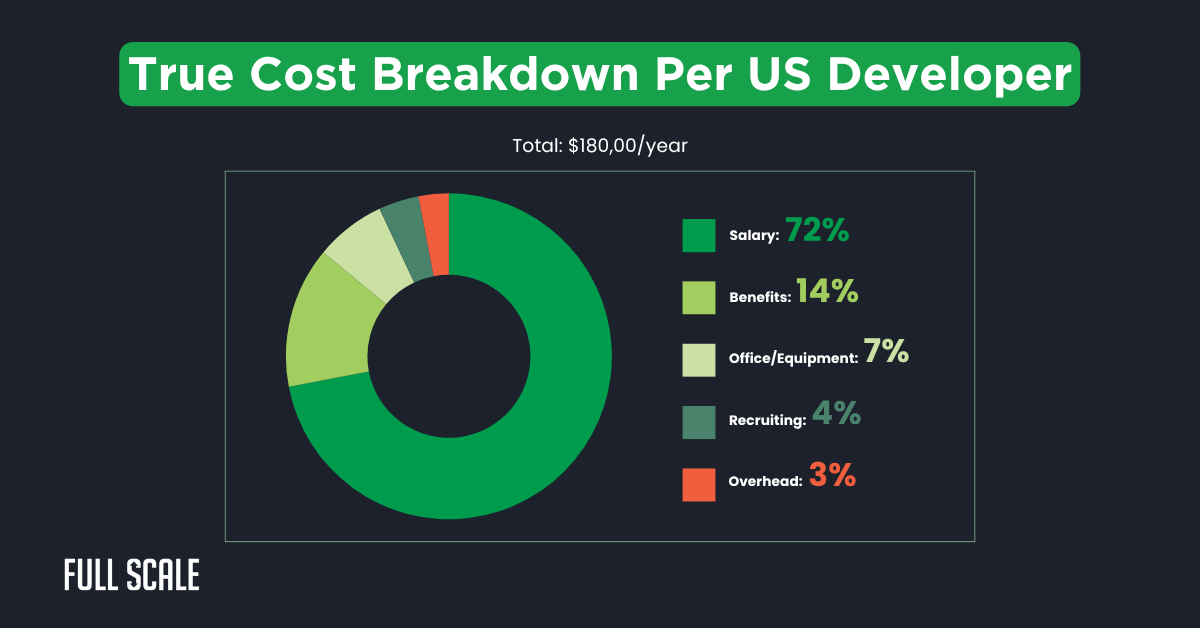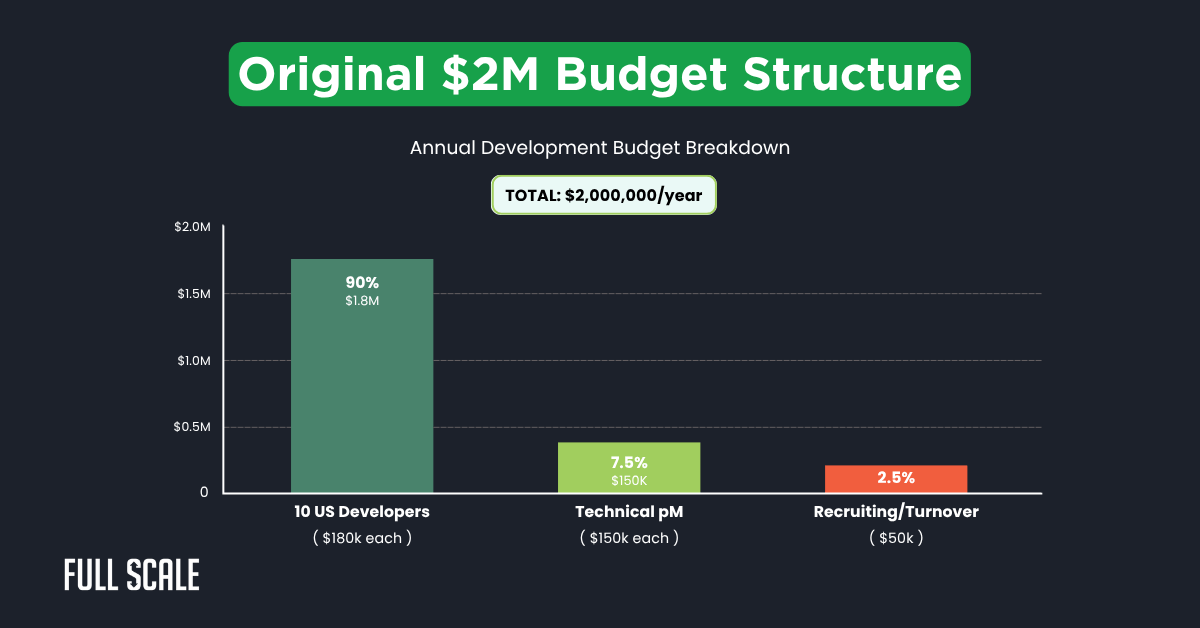One of our healthtech clients achieved remarkable software development budget optimization, slashing their budget from $2M to $1.2M without cutting features. This transformation demonstrates how smart resource allocation can revolutionize engineering economics.
Here’s the exact financial breakdown that helped them save $800,000 annually while improving team performance.
Key takeaways from this case study:
- The 40/60 hybrid model (40% local, 60% offshore) delivers 40% cost savings without quality sacrifice
- Hidden costs like turnover and overhead make US developers cost $180,000/year, not just their salary
- Strategic team restructuring reduces turnover from 20% to 5% while scaling faster
- Implementation takes just 90 days with our proven roadmap and quality safeguards
The 40% Cost Reduction Formula
Most companies don’t realize their true developer costs until they see the complete breakdown. The average US developer costs $180,000 annually when you include all hidden expenses. According to Stack Overflow’s 2024 Developer Survey, 73% of companies underestimate their actual per-developer costs by 30% or more.
Quick Cost Comparison
Bottom Line: Replace 6 local developers with offshore talent to save $720,000 per year without sacrificing quality.
The Real Cost of Your Development Team
Understanding your actual development costs is the first step to reduce software development budget effectively. Most CTOs only see salaries, missing the expensive iceberg underneath.
Let’s expose what you’re really paying for each team member.
The Hidden Multiplier Effect
Your developer’s salary represents only 60-70% of their actual cost to your company. Benefits, office space, equipment, and recruiting fees create a costly multiplier effect. This reality check often shocks even experienced tech leaders managing distributed teams.

This breakdown reveals why development expense reduction requires looking beyond salaries. Each developer costs 40% more than their paycheck suggests. Smart companies leverage this knowledge to implement staff augmentation strategies that cut development costs by 40% through strategic team restructuring.
The Turnover Tax
Developer turnover silently destroys budgets through replacement costs and lost productivity. The average 13.2% annual turnover rate costs companies $33,000 per departed developer. According to the Work Institute’s 2024 Retention Report, tech companies with remote development teams experience 40% lower turnover than traditional office-based teams.
| Turnover Cost Factor | Cost Impact | Time Impact |
| Recruiting & Interviews | $15,000 | 2-3 months |
| Onboarding & Training | $8,000 | 1-2 months |
| Lost Productivity | $10,000 | 3-6 months |
| Total Per Developer | $33,000 | 6-11 months |
These hidden costs compound quickly, making software development budget optimization essential for sustainable growth. Forward-thinking companies recognize that investing in retention through flexible work arrangements pays dividends.
The $2M to $1.2M Transformation
Our healthtech client’s journey from $2M to $1.2M demonstrates practical software development budget optimization in action. They maintained full feature delivery while achieving massive savings through strategic restructuring.
Let’s examine their exact numbers and transformation strategy that made this possible.
Before: The $2M Budget Breakdown
The client’s original structure followed typical Silicon Valley patterns with predictable cost inefficiencies. Ten local developers, one technical PM, and standard turnover created their $2M annual burn. This model trapped them in an expensive cycle that limited their growth potential.

This traditional approach left no room for scaling without proportionally increasing costs. The client realized they needed a fundamental shift in their development model to achieve sustainable growth.
After: The Optimized $1.2M Structure
Strategic team restructuring created their new $1.2M budget without sacrificing capabilities. The hybrid model balanced local leadership with offshore execution talent. This software project cost reduction approach delivered immediate ROI while improving team dynamics.
Their optimized structure kept critical architects local while leveraging global talent for execution. Smart integration tools and quarterly team building maintained cohesion. The result exceeded expectations: 40% lower costs with 95% developer retention.
Optimized Budget Breakdown
- 4 US Senior Developers: $720,000
- 6 Offshore Senior Developers: $360,000
- Integration Tools: $20,000
- Quarterly Team Building: $40,000
- Transition Buffer: $60,000
- New Total: $1,200,000 (40% savings)
The Strategy for Software Development Budget Optimization
Cutting costs without cutting corners requires a systematic approach to team restructuring. The key is maintaining quality while optimizing resource allocation globally. This proven strategy helps reduce software development budget optimization without cutting features through intelligent team composition.
The 40/60 Hybrid Model
Keep 40% of your team local for architecture, leadership, and critical decision-making roles. Place 60% offshore for execution, implementation, and specialized technical work. This balance ensures quality control while maximizing cost savings through global talent arbitrage.
Direct integration eliminates costly middlemen and communication barriers that plague traditional outsourcing. Your offshore team joins all standups, uses the same tools, and integrates seamlessly. They become true team members, not external contractors, fostering genuine collaboration.
The Quality Safeguards
Software development budget optimization only works with proper quality controls in place. Apply the same technical hiring bar regardless of geography. Focus on developer retention through career growth and comprehensive benefits that rival any tech company.
| Quality Safeguard | Implementation | Result |
| Technical Standards | Same coding tests, same interview process | Consistent quality |
| Communication | 4-hour minimum overlap, same tools | Seamless collaboration |
| Retention Focus | Full benefits, career development | 95% retention rate |
| Integration | Direct team membership, no middlemen | True team cohesion |
These safeguards transform offshore hiring from a risk into a competitive advantage. Companies implementing these practices report higher code quality than their previous all-local teams.
Implementation Roadmap for Development Budget Optimization
Your journey to lower development costs starts with a structured 90-day implementation plan. This roadmap minimizes risk while maximizing software development savings potential. Each phase builds on the previous, ensuring a smooth transition without disrupting current projects.
Week 1-2: Audit Your Current Costs
Calculate the true cost per developer, including all hidden expenses and overhead. Comprehensively document your current processes, communication patterns, and team dynamics. Based on collaboration requirements, identify which roles best suit the hybrid model.
Create a detailed cost breakdown using our framework to understand your baseline metrics. Include turnover costs, recruiting expenses, and productivity losses that are often overlooked. This audit reveals your actual savings potential and helps set realistic expectations.
Week 3-4: Design Your Hybrid Structure
Define clear distinctions between core leadership roles and execution positions strategically. Establish communication protocols that ensure a minimum of a 4-hour daily overlap for real-time collaboration. Choose integration tools that effectively support seamless collaboration across time zones.
Map out your ideal team structure, balancing local and offshore talent optimally. Set clear expectations for each role and interaction patterns from day one. Design onboarding processes that integrate offshore developers immediately into your team culture.
Week 5-8: Pilot Program
Start with 2-3 offshore developers paired with senior local team members initially. Measure velocity, code quality, and communication effectiveness throughout the pilot phase. Gather feedback from both local and offshore team members weekly for continuous improvement.
Use this phase to refine processes and address any integration challenges proactively. Track metrics that matter: deployment frequency, bug rates, and team satisfaction scores. Adjust communication patterns based on real experience rather than assumptions.
Week 9-12: Scale and Optimize
Expand the offshore team based on pilot success and refined processes systematically. Continue monitoring quality metrics and team dynamics during scaling carefully. Calculate actual ROI comparing pre and post-implementation costs for stakeholder reporting.
Fine-tune the model based on three months of real-world data and feedback. Celebrate wins and address remaining friction points systematically for continuous improvement. Document best practices for future team members joining your optimized structure.
The ROI Calculator Framework
Understanding your potential savings requires accurate calculation of current and optimized costs. This development ROI calculator helps you model different scenarios precisely. Use it to build your business case for change with concrete projections.
Development Cost Optimization Calculator
Calculate your potential savings with strategic team restructuring
Your Optimization Results:
Current Annual Cost:
Optimized Annual Cost:
Annual Savings:
Break-even Timeline:
Based on $50,000 implementation cost
Your Optimized Team Structure:
This calculator demonstrates how development cost management strategies create an immediate impact financially. Most companies see 30-45% savings within the first year consistently. Your exact savings depend on team size and current cost structure factors.
Common Objections With Data-Backed Answers
Every CTO considering offshore development cost savings faces similar concerns initially. Let’s address these objections with real data from 60+ implementations. Facts beat fear when making strategic decisions about team structure.
“But what about quality?”
Code quality depends on hiring standards, not geography or time zones. Our clients maintain the same technical bar globally without compromise. The result: 95% developer retention and consistent code quality metrics across all teams.
Quality comes from process, not location, as proven repeatedly. Direct integration, code reviews, and pair programming work identically with distributed teams. Your offshore developers become true team members, not external contractors, ensuring accountability.
“Communication will suffer.”
Modern tools eliminate traditional offshore communication barriers completely. Slack, Zoom, and Jira work identically across time zones seamlessly. Four-hour daily overlap ensures real-time collaboration when needed most critically.
Direct access removes the middleman problem plaguing traditional outsourcing models. Your team communicates directly with developers, not project managers inefficiently. This model creates better communication than many local teams paradoxically. GitLab’s 2024 Remote Work Report shows that structured remote teams have 23% higher communication satisfaction than co-located teams.
“Hidden costs will eat the savings.”
All costs are transparently included in our software development budget optimization model. No recruitment fees, no surprise charges, and predictable monthly expenses are guaranteed. The calculator above comprehensively includes integration costs and reasonable buffers.
Traditional outsourcing hides costs in change requests and communication overhead, frustratingly. Staff augmentation eliminates these issues through direct employment relationships. Finally, you get transparency and predictability in your development budget.
Your Next Step in Development Cost Optimization
Smart CTOs recognize that reducing software development costs doesn’t mean reducing quality. The math proves that strategic team structuring delivers both savings and improvements. Your competition is already making this shift successfully.
Quick Assessment Tool
Evaluate your readiness for software development budget optimization with these quick questions. If you answer yes to any, you’re ready for transformation immediately. The potential savings justify immediate action based on our experience.
Ready for Optimization? Check All That Apply:
Your Assessment Results:
Next Steps:
The Bottom Line
Our healthtech client transformed their development economics through strategic software development budget optimization successfully. The results speak volumes about this approach’s effectiveness:
- $800,000 annual savings achieved without cutting features or quality
- 40% cost reduction while scaling from 10 to 16 developers
- 95% developer retention compared to the 80% industry average
- 2 major features shipped ahead of schedule due to increased team efficiency
- Break-even achieved in just 2.5 months with sustained savings thereafter
How Full Scale Makes This Transformation Possible
Full Scale specializes in helping companies achieve dramatic software development budget optimization through our proven model. We’ve refined this approach across 60+ client implementations over 5 years. Our difference lies in direct integration without middlemen or hidden fees.
We provide:
- Vetted senior developers who match your technical standards exactly
- Direct team integration with your existing workflows and tools
- Transparent pricing with no recruitment fees or surprise costs
- 95%+ retention rates through developer-first employment practices
- Month-to-month flexibility so you’re never locked into long contracts
Ready to reduce development costs without cutting features for our client? Calculate your potential savings using our ROI framework above first. Then let’s discuss how to implement these strategies for your specific situation.
Transform your development economics like our health tech client did successfully. Turn your $2M budget into $1.2M while building better, faster, and consistently. The first step starts with completely understanding your true costs today.
Get Your Free Development Cost Analysis.
FAQs: Software Development Budget Optimization
How quickly can I implement software development budget optimization in my company?
Most companies complete initial implementation within 90 days following our roadmap. The pilot phase starts showing results within 4-6 weeks typically. Full optimization with a hybrid team model takes 3-6 months for complete integration.
What’s the minimum team size for offshore development cost savings to make sense?
Teams with 5+ developers see immediate ROI from software development budget optimization strategies. Smaller teams benefit from reduced hiring time and access to specialized skills. The sweet spot for maximum savings starts at 10+ developer teams.
How do you ensure code quality when you reduce software development budget optimization through offshoring?
Quality comes from standards, not geography, in modern software development. We maintain identical technical assessments, code review processes, and performance metrics globally. Our 95% retention rate proves developers thrive in this software development budget optimization model.
What happens if the offshore team doesn’t work out for our software project cost reduction goals?
Our month-to-month contracts eliminate long-term risk completely. The pilot program identifies any issues before full implementation begins. Most concerns disappear within the first sprint when teams experience seamless integration.
Can this development cost management strategy work for early-stage startups?
Absolutely, startups benefit most from software development budget optimization approaches. Access to senior developers at 60% lower cost extends the runway significantly. Many successful startups built their entire technical teams using this model.

Matt Watson is a serial tech entrepreneur who has started four companies and had a nine-figure exit. He was the founder and CTO of VinSolutions, the #1 CRM software used in today’s automotive industry. He has over twenty years of experience working as a tech CTO and building cutting-edge SaaS solutions.
As the CEO of Full Scale, he has helped over 100 tech companies build their software services and development teams. Full Scale specializes in helping tech companies grow by augmenting their in-house teams with software development talent from the Philippines.
Matt hosts Startup Hustle, a top podcast about entrepreneurship with over 6 million downloads. He has a wealth of knowledge about startups and business from his personal experience and from interviewing hundreds of other entrepreneurs.




